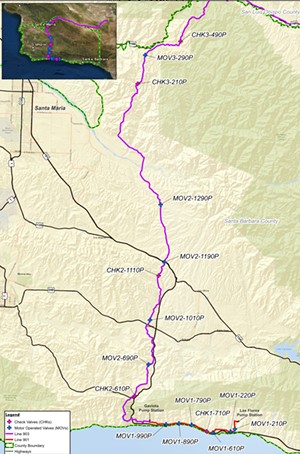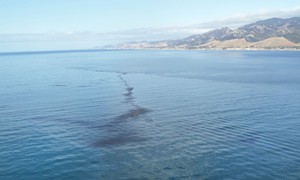Prroposal to put in new safety valves on an oil pipeline looks straightforward but raised a lot of questions.
“This was brought to us as, ‘Look, this is simple. It’s just putting safety valves, required by law,’” said Santa Barbara County Planning Commissioner John Parke, who represents the 3rd District. “There [are] a lot of ifs and uncertainties out there that are surprising to the public. They certainly woke up and made a lot of noise at the hearing.”
On March 1, Plains Pipeline L.P.’s proposed plan went before the Planning Commission, which punted a decision to a later meeting. It includes installing 16 new safety valves along the existing pipeline that caused the Refugio oil spill in 2015—which released 123,000 gallons of crude oil into the ocean and along the coast. The pipeline runs from the Gaviota Coast to the Los Padres National Forest and hasn’t operated since the 2015 spill.

The company said it proposed the project in order to comply with Assembly Bill 864, which mandates that oil operators install the best available technology on pipelines in the coastal zone. Although Plains Pipeline L.P. proposed the project, Pacific Pipeline—a subsidiary of ExxonMobil—purchased the lines in October 2022 and would be overseeing the lines once the change of ownership is processed, according to the county staff report.
Staff approved the proposal in August 2022, but The Gaviota Coast Conservancy, the Tautrim family, and Greyfox LLC appealed that decision in September due to restart concerns.
If commissioners uphold the project approval, oil operations could resume on existing equipment without additional environmental review, since the company already has previous entitlements and went through the environmental review process for the pipeline, Parke told the Sun.
“After years of hearing there will be a new pipeline, now we’re essentially hearing there might be use of the old pipeline, and that’s what the appellants are really pushing,” he said.
This follows Exxon’s other attempts to restart operations with the initial proposal to replace the entire pipeline—which was filed after the spill and is still in the environmental review process, Gaviota Coast Conservancy attorney Ana Citrin told the Sun.
In 2017, Exxon filed a proposal to truck crude oil along Highways 101 and 166 from its Santa Ynez Unit Las Flores Canyon processing facility to the Santa Maria Pump Station or to the Plains Pentland Terminal in Kern County, according to previous Sun reporting. The trucking proposal would have enabled the company to restart its offshore oil operations. The Santa Barbara County Board of Supervisors denied that proposal.
Following that decision, Exxon sued the county for violating its privacy-related state and U.S. constitutional rights, and the first court hearing is scheduled for June 16.
“They wanted to get oil out while the pipeline issue is getting resolved, and still today we are [looking at] putting safety valves on a pipeline that’s not going to be used anymore,” Planning Commissioner Parke said.
Alongside filing the lawsuit, Exxon sold the Santa Ynez Unit’s onshore and offshore operations to Sable Offshore Corporation for $643 million and set the goal of restarting operations by 2024, according to a presentation for investors—a point highlighted by several people in public comment during the March 1 Planning Commission meeting.
In the Planning Commission meeting, the project applicants argued that restarting operations wasn’t the issue in front of commissioners; the company was only looking to stay in compliance with AB 864 and not have the pipeline decommissioned.
“The whole issue is do we address just the valves or this bigger issue?” Parke told the Sun after the meeting. “And that’s where there’s a split on the commission and needs to get clarified for this next hearing.”
The Planning Commission directed staff to conduct further research and bring the project appeal back at its April 26 meeting with options to conduct additional environmental review on using the existing pipeline, Citrin said.
“Clearly, the valve installation project is not the same as restart; they’re different. But the valves are being installed in order to utilize the existing pipeline,” Citrin told the Sun.
In order to restart operations with the existing pipeline, Exxon would have to get a waiver from the state fire marshal, which oversees oil operations, saying it’s OK to operate, Citrin said. However, they’d have to demonstrate there’s been no change in circumstances since the line’s 1985 environmental review that could cause significant impacts.

As part of the pipeline’s approval in the ’80s, a cathodic protection system was added to prevent corrosion and bursting pipes, but after the 2015 Refugio Spill, an investigation into the pipeline found that the system failed, Citrin said.
“If circumstances were the same, they’d be putting valves on the pipeline in the ’80s, which had external protection, but what’s actually happening is they are putting valves on a pipeline that has had substantial change and needs to be analyzed for impact—specifically, a subsequent environmental impact report is what we are saying is required,” Citrin said.
A representative from Plains Pipeline declined to comment since the company is no longer the owner of the pipeline, and attorneys representing the applicant could not be reached before the Sun’s deadline.
Santa Maria Valley Chamber of Commerce President and CEO Glenn Morris told the Sun that the Planning Commission should move the project forward because it’s a continuation of existing business operations with an organization that’s been present in the county and has followed its rules and regulations for many years.
“It’s really about giving an existing business the ability to do maintenance and upgrades to their existing assets so they can continue to operate in the safest and most compliant means possible with state and federal guidelines,” Morris said.
The Planning Commission’s decision surprised Morris since county staff and counsel recommended approval, but unless the appeal demonstrates “significantly new or different information” than what was presented when staff approved the project, the commission should uphold the approval, Morris said.
“They should only overturn or continue to review if somebody comes in and says the staff missed this data point or new information that changes the facts on the ground. My sense is that it was not that—it was people’s personal opinions about the value of what this business does, but it didn’t change the facts,” he said.
From his perspective, the Refugio spill is not new information since it happened eight years ago, and the chamber is confident that county staff considered all of that information in the application for the permit.
“There are obviously people in the community [who] would like to see these types of businesses go away, but that’s not where we are today. There continues to be demand and need for their product,” Morris said. “The questions should be, ‘How do we help them operate in an efficient and safe way?’ That’s what we think the role of the county should be, so they aren’t a part of the obstacle to it happening at all.”
Reach Staff Writer Taylor O’Connor at [email protected].










